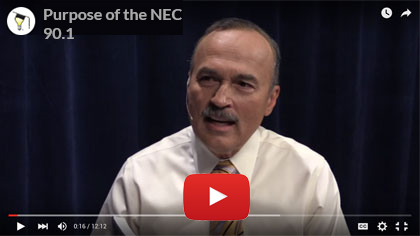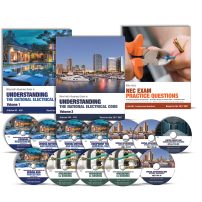|
 Keeping up with the requirements of the Code should be the goal of everyone involved in electrical safety. As part of my efforts to provide free resources to help the industry, I will be sending out a monthly newsletter, each with what I feel is an important rule in the 2017 NEC®, complete with graphics and a video. I encourage you to use it as a training resource for your organization, and share with your colleagues. Keeping up with the requirements of the Code should be the goal of everyone involved in electrical safety. As part of my efforts to provide free resources to help the industry, I will be sending out a monthly newsletter, each with what I feel is an important rule in the 2017 NEC®, complete with graphics and a video. I encourage you to use it as a training resource for your organization, and share with your colleagues.

The content below is extracted from Mike Holt's Understanding the 2017 National Electrical Code®, Volume 1.
Any underlined text denotes a change to the Code for the 2017 NEC.
Introduction to Article 90 - Introduction to the National Electrical Code
Many NEC violations and misunderstandings wouldn't occur if people doing the work simply understood Article 90. For example, many people see Code requirements as performance standards. In fact, the NEC requirements are bare minimums for safety. This is exactly the stance electrical inspectors, insurance companies, and courts take when making a decision regarding electrical design or installation.
Article 90 opens by saying the NEC isn't intended as a design specification or instruction manual. The National Electrical Code has one purpose only, and that's the practical safeguarding of persons and property from hazards arising from the use of electricity. The necessity of carefully studying the NEC rules can't be overemphasized, and the role of textbooks such as this one are to help in that undertaking. Understanding where to find the rules in the Code that apply to the installation is invaluable. Rules in several different articles often apply to even a simple installation.
Article 90 then describes the scope and arrangement of the NEC. The balance of this article provides the reader with information essential to understanding the Code rules.
Typically, electrical work requires you to understand the first four chapters of the NEC which apply generally, plus have a working knowledge of the Chapter 9 tables. That understanding begins with Article 90. Chapters 5, 6, and 7 make up a large portion
of the Code, but they apply to special occupancies, special equipment, or other special conditions. They build on, modify, or amend the rules in the first four chapters. Chapter 8 contains the requirements for communications systems, such as twisted pair conductors for telephone and data systems, satellite receivers, antenna systems, and coaxial cable wiring. Communications systems (twisted wire, antennas, and coaxial cable) aren't subject to the general requirements of Chapters 1 through 4, or the special requirements of Chapters 5 through 7, unless there's a specific reference in Chapter 8 to a rule in Chapters 1 through 7. |
90.1
|
Purpose of the NEC
|

|

|
(A) Practical Safeguarding. The purpose of the NEC is to ensure that
electrical systems are installed in a manner that protects people and
property by minimizing the risks associated with the use of electricity.
It isn't a design specification standard or instruction manual for the
untrained and unqualified. ▶Figure 90“1
.jpg)
|
|
Figure 90-1 |
| Author's Comment: |
- The Code is intended to be used by those skilled and knowledgeable
in electrical theory, electrical systems, construction,
and the installation and operation of electrical equipment.
|
(B) Adequacy. The Code contains requirements considered necessary
for a safe electrical installation. If an electrical system is installed
in compliance with the NEC, it will be essentially free from electrical
hazards. The Code is a safety standard, not a design guide.
NEC requirements aren't intended to ensure the electrical installation
will be efficient, convenient, adequate for good service, or suitable for
future expansion. Specific items of concern, such as electrical energy
management, maintenance, and power quality issues aren't within the
scope of the Code. ▶Figure 90“2
.jpg)
|
|
Figure 90-2 |
Note: Hazards in electrical systems often occur because circuits are overloaded
or not properly installed in accordance with the NEC. These often occur if the initial
wiring didn't provide reasonable provisions for system changes or for the increase
in the use of electricity. ▶Figure 90“3
Note.jpg)
|
|
Figure 90-3 |
| Author's Comment: |
- See the definition of Overload in Article 100.
- The NEC doesn't require electrical systems to be designed or installed to accommodate future loads. However, the electrical
designer (typically an electrical engineer) is concerned with
not only ensuring electrical safety (Code compliance), but also
with ensuring the system meets the customers' needs, both
of today and in the near future. To satisfy customers' needs,
electrical systems are often designed and installed above the
minimum requirements contained in the NEC. But just remember,
if you're taking an exam, licensing exams are based on your
understanding of the minimum Code requirements.
|
(C) Relation to International Standards. The requirements of the NEC address the fundamental safety principles contained in the International
Electrotechnical Commission (IEC) Standard, including protection against
electric shock, adverse thermal effects, overcurrent, fault currents, and
overvoltage. ▶Figure 90“4
.jpg)
|
|
Figure 90-4 |
| Author's Comment: |
-
The NEC is used in Chile, Ecuador, Peru, and the Philippines.
It's also the Electrical Code for Colombia, Costa Rica, Mexico,
Panama, Puerto Rico, and Venezuela. Because of these adoptions,
it's available in Spanish from the National Fire Protection
Association, 617.770.3000, or www.NFPA.org.
|

|
We'd love to hear from you about this series, and the ways you're using it. Send us your comments and feedback by clicking on Post a Comment below. Look out for the next part in this series a month from now, and please share with your colleagues.
This content is extracted from Mike Holt's Illustrated Guide to Understanding the 2017 National Electrical Code, Volume 1 textbook.
To review or catch up on previous newsletters on the National Electrical Code click here.
 |
Learn More
Understanding the NEC Complete Library
(3 books | 12 DVDs)


For further information about this or other products please call us at 888.632.2633
We look forward to helping you
|

|
|
|

